Launching your online business requires a solid foundation, and a crucial first step is choosing the right platform to build your online store. Two names that consistently rise to the top are Drupal vs Shopify. Both offer powerful tools and features, but their approaches to building and managing an eCommerce website differ.
For this reason, LitExtension – #1 eCommerce Migration Service has written this comprehensive guide. By breaking down the differences between the two platforms, you will be able to determine which platform aligns best with your business goals. In this article, we will walk you through the following headings:
- An overview of Shopify vs Drupal;
- A platform selection guide for Drupal vs Shopify;
- The key differentiators between the two platforms.
Keep scrolling to find out the answer!
Shopify vs Drupal: An Overview of Both Platforms
Both Drupal vs Shopify are considered top contenders among various eCommerce platforms. Nevertheless, their underlying architecture and approaches to building online stores cater to very different needs and skill sets. Before going into a detailed comparison, let's clearly understand what each platform offers.
Shopify overview
If you dream of owning an online store, you'll likely cross paths with Shopify. This subscription-based service lets users build their own online businesses using its intuitive platform of tools and apps. Shopify provides everything you need, from website creation and design to payment processing, shipping logistics, and marketing tools.

Best of all, Shopify takes the mystery out of technical complexities. You don't need to be a coding expert to launch a professional-looking and fully functional eCommerce website. With intuitive design tools, you can build the online store you've always envisioned, even if you've never written a line of code.
Shopify Pros | Shopify Cons |
|
|
Drupal overview
Then we have Drupal – a free and open-source content management system (CMS) known for its flexibility and power. Unlike website builders that provide pre-designed templates, Drupal gives developers the freedom to create highly tailored digital experiences using its robust framework.
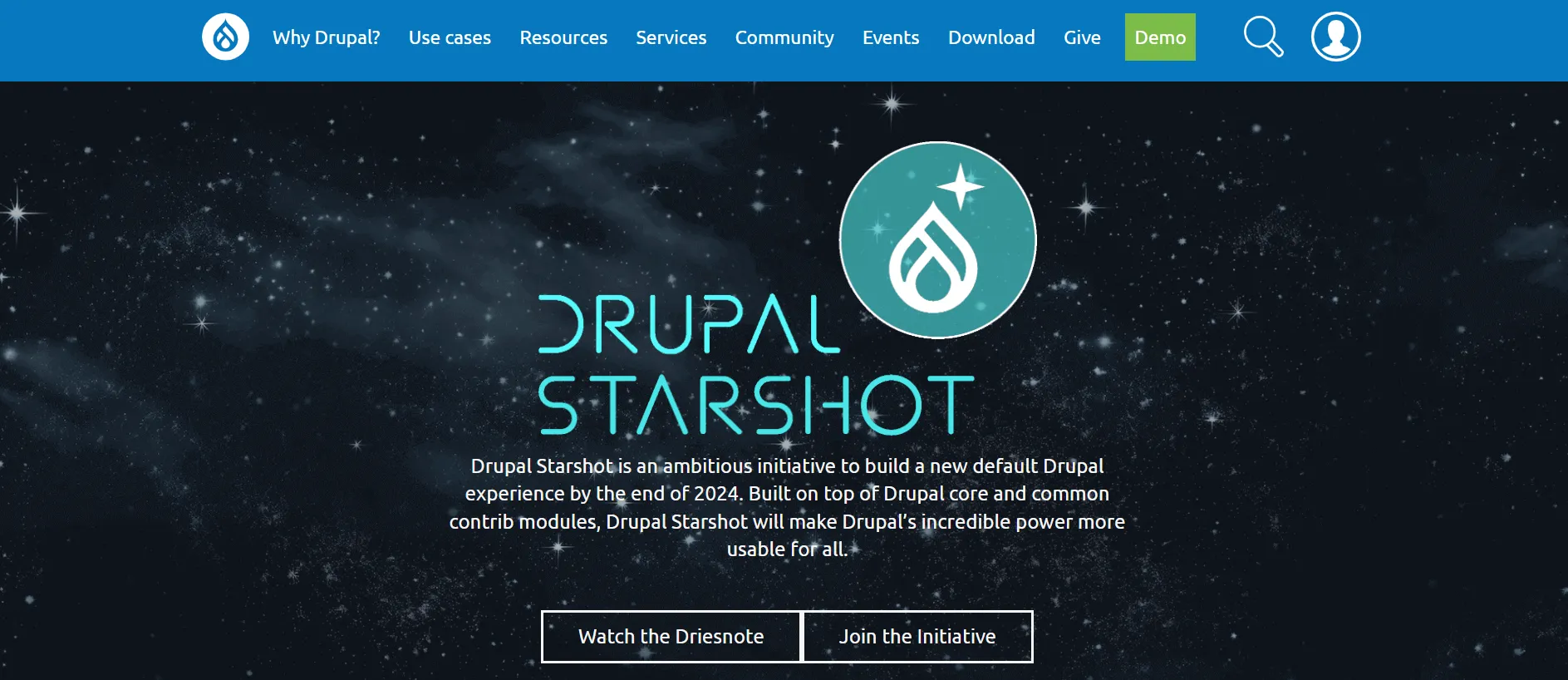
One more thing we love about Drupal is its flexibility. Whether you are building a streamlined blog or a robust eCommerce store, Drupal's open-source nature gives you complete control. For this reason, Drupal is often the top choice for enterprise-level websites, community platforms, news portals, and web applications requiring intricate features and integrations.
Drupal Pros | Drupal Cons |
|
|
Drupal vs Shopify: Which Platform Should You Go For?
Both Shopify and Drupal represent two distinct paths to establishing your presence in the eCommerce world. So, how do you know which platform is the right fit for your business? Let's have a look at their key audiences:
Shopify is for:
- Entrepreneurs and businesses of all sizes seek an all-in-one, easy-to-use platform to build and manage their online stores.
- Users with little to no coding experience want a hassle-free way to create a professional-looking and fully functional e-commerce website.
- Businesses primarily focus on selling physical or digital products and want built-in tools for inventory management, payment processing, shipping, and marketing.
Drupal is for:
- Developers and organizations with technical expertise seek a highly customizable and scalable CMS to build complex websites and applications.
- Websites with advanced functionality requirements, such as intricate data structures, custom user roles, and integrations with third-party systems.
- Projects that prioritize flexibility and control over ease of use, where developers have the skills and resources to leverage Drupal's powerful framework for custom development.
Drupal vs Shopify: Breaking Down the Differences
To give you a clearer picture of how these platforms stack up, let’s start with a head-to-head comparison across key aspects of Drupal vs Shopify:
Features | Drupal | Shopify | Winner |
Pricing | Starts from $200/month | Starts from $5 to 2,500+/month | A tie |
Ease of use | Requires a higher level of technical expertise for setting up. | Offers a streamlined setup process with its intuitive interface and step-by-step guidance. | Shopify |
Themes & customization |
|
| Drupal |
eCommerce features |
|
| Shopify |
Apps & integration | 52,000+ modules | 13,000+ apps | Shopify |
Marketing & SEO | Robust marketing automation features with integrated SEO tools | Powerful email marketing campaigns with basic SEO tools | A tie |
Security | Two-factor authentication (2FA) and frequent security updates | SSL Certificates, Fraud Analysis, 24/7 Security Monitoring | Drupal |
Customer support | No centralized customer support team. Access support via community, forums, documentation | 24/7 customer support via phone call, live chat, and email | Shopify |
Now, let’s gain insights into each category and explore the features of Drupal vs Shopify!
1. Pricing (A tie)
Staying within budget is crucial for sustainable growth when launching your online business. Choosing the right platform means carefully considering the costs involved, both upfront and in the long run. Let's examine the pricing structures of Drupal and Shopify, revealing the potential financial implications for your business.
Drupal pricing
While Drupal is free to use, building and maintaining a Drupal website comes with associated costs that vary depending on your needs and choices. Here’s a breakdown of potential expenses:
- Domain name ($10/year);
- Drupal hosting fee (from $4/month);
- Paid theme (from $20/month);
- Plugins ($0 – $1000);
- Developer fees ($40/hr).
We can see that the cost of building a website with Drupal varies based on several factors, ranging from $200 to $20,000/year. Key considerations include your location, the duration you hire a developer, the areas requiring support, and more.
Apart from the platform pricing, you should also consider transaction fees when planning your budget. With Drupal, the transaction fees depend on which third-party payment gateway you are working with. Typically, popular payment gateways like Stripe or PayPal apply a standard rate of around 2.9% + $0.30 per transaction.
Shopify pricing
In contrast to Drupal's modular pricing structure, Shopify offers predictable monthly subscription plans with set features and costs. More specifically, here are the pricing plans you may choose from when signing up for Shopify:
- Shopify Basic (for solo entrepreneurs): 19$/month;
- Shopify (for small teams): $49/month;
- Advanced Shopify (as your business scales): $299/month;
- Shopify Plus (complex, enterprise-level needs): Starting at $2,300/month.
Also, Shopify offers its own payment gateway, Shopify Payments, which eliminates transaction fees on your sales. However, if you opt for a third-party payment gateway, additional transaction fees apply based on your Shopify plan:
- Shopify Basic: 2.0% per transaction;
- Shopify: 1.0% per transaction;
- Advanced Shopify: 0.5% per transaction.
Similarly, Shopify offers tiered pricing for online credit card rates:
- Basic Shopify: 2.9% + 30 cents per transaction;
- Shopify: 2.6% + 30 cents per transaction;
- Advanced Shopify: 2.4% + 30 cents per transaction.
As you can see, while higher-tier Shopify plans come with higher monthly costs, they offer savings on transaction and credit card processing fees, which can be advantageous for businesses with significant sales volume.
The Verdict
In the battle of Drupal vs Shopify for affordability, it’s a tie between the two. Shopify's subscription model offers simplicity, while Drupal's modular pricing provides flexibility but requires careful cost management for complex projects.
2. Ease of use (Shopify wins)
A user-friendly platform is key to business growth, allowing you to focus on what matters instead of technical headaches. It streamlines workflows, speeds up launches, and saves money long-term. Let's see how Drupal and Shopify compare in terms of ease of use.
Drupal ease of use
Drupal, known for its flexibility and customization options, isn't typically recognized for its user-friendliness, especially for beginners. Building and managing a Drupal website often requires a grasp of technical concepts and at least some familiarity with coding.

While a visual interface exists for basic tasks, unlocking Drupal’s full potential often necessitates working with code and configuring modules. To mitigate the technical complexity, you can hire an experienced developer. Our advice for this is that you should factor in the added cost and communication overhead.
Shopify ease of use
On the other hand, user-friendliness is one of Shopify's key advantages. It's built on a user-centric, intuitive design that makes creating and managing an online store remarkably straightforward, even for those without coding experience.
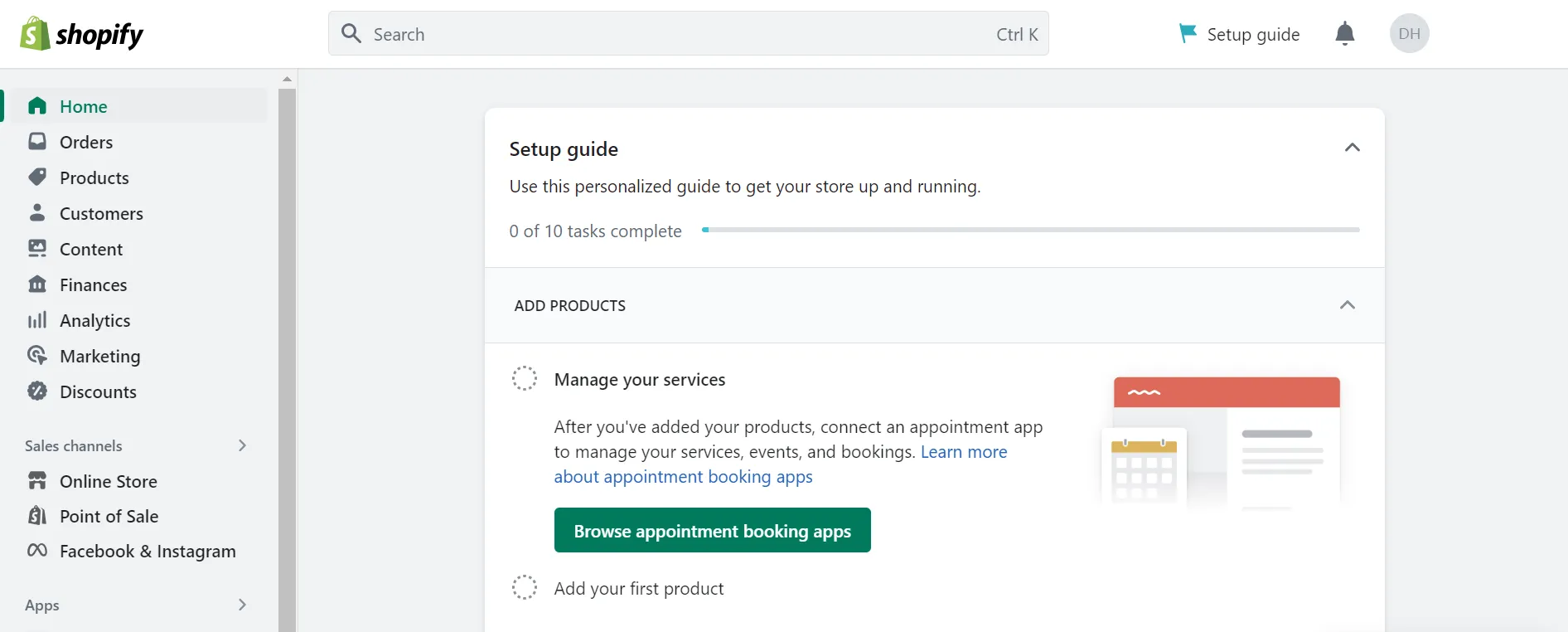
With a Shopify account, simply access the Shopify Dashboard to begin. The dashboard is user-friendly, with categories and related sub-sections for easy navigation. You can quickly import products, make final adjustments, and have your store ready to launch.
The Verdict
It is clear that Shopify is the clear winner against Drupal in terms of ease of use. Its intuitive design, drag-and-drop interface, and all-in-one platform empower users with technical expertise to build and manage their online stores with remarkable ease.
3. Themes & customization (Drupal wins)
Another crucial aspect to consider when choosing between Drupal vs Shopify is the variety of themes and customization options available. A platform that provides flexible, customizable themes allows businesses to tailor their store's appearance to match their brand identity.
Drupal customization
Drupal offers over 3,000 attractive themes as a foundation for your website's appearance. However, most Drupal users choose to create custom themes for greater control over their storefront design.
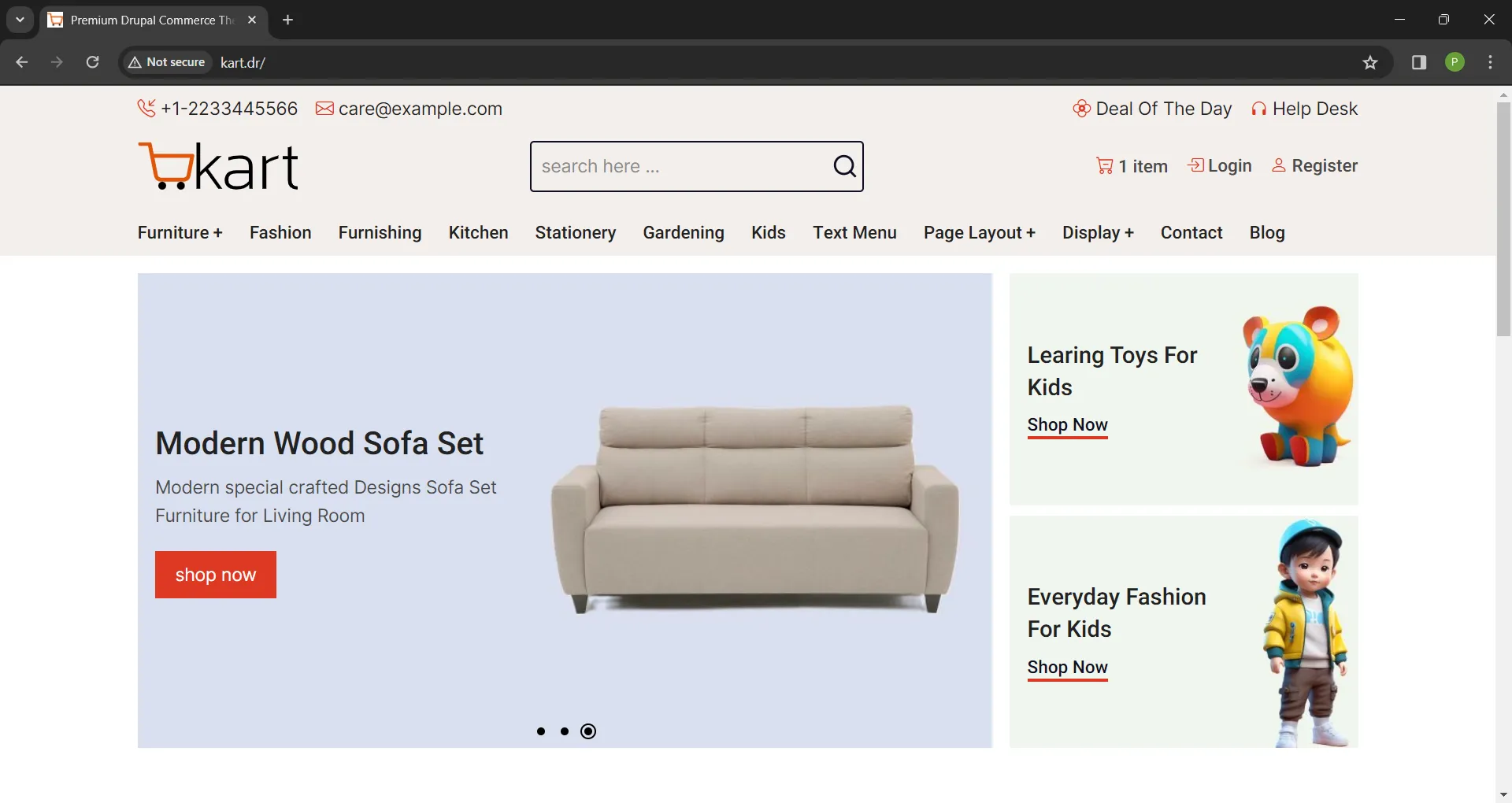
There’s nearly no limit to website customization when using Drupal. With its Drupal Commerce module, you can craft a unique online store that perfectly aligns with your brand's vision. Whether it's through custom product layouts, intricate design elements, or specialized workflows, Drupal provides unparalleled flexibility to tailor every aspect of your eCommerce site.
Having said that, Drupal relies heavily on manual coding for customization. This presents a significant challenge for users without technical skills, as creating a polished and unique online store on Drupal demands significant coding expertise.
Shopify customization
Meanwhile, Shopify simplifies the design process with its extensive collection of 210+ pre-made themes, offering both free and paid options to suit various aesthetic preferences and budgets. These themes are categorized by industry and catalog size, making it easy to find a starting point that aligns with your brand.
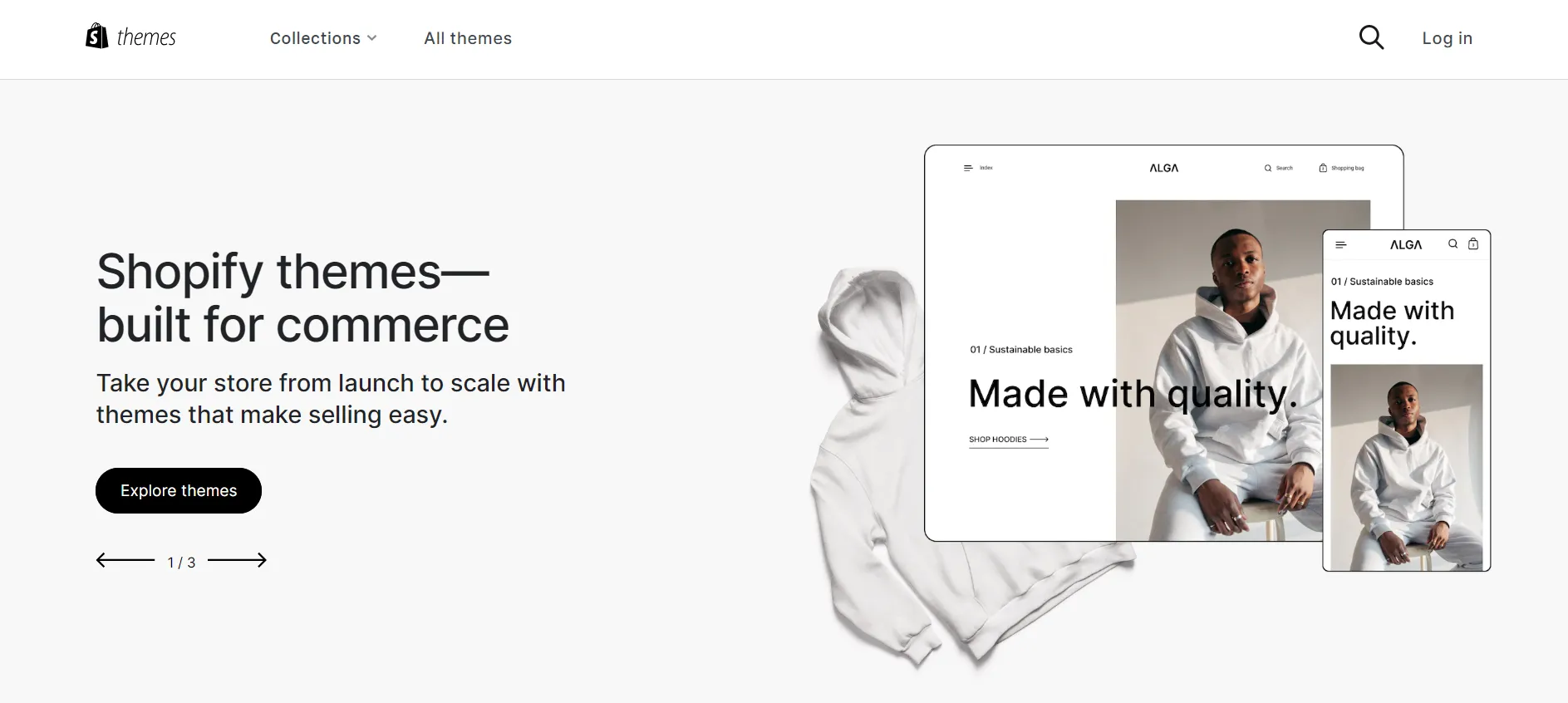
Even though Shopify is user-friendly and feature-rich, it operates within a more standardized framework that can limit design possibilities. Its pre-built themes and customization options are useful for quick deployment but may not cater to more complex or unique design needs. For more advanced customizations, Shopify utilizes its own templating language called Liquid, offering greater flexibility for users with coding knowledge.
The Verdict
For businesses that prioritize a highly customized design and want full control over the look and feel of their online store, Drupal stands out as the superior choice. Its ability to deliver a tailored, distinctive eCommerce experience makes it ideal for those who require a more personalized approach to design and functionality.
4. eCommerce features (Shopify wins)
If your sights are set on selling products or services online, conducting research into the eCommerce features of each platform is a non-negotiable step. Thus, we will break down the detailed features provided by the two platforms to support your business.
Note: Drupal provides its eCommerce capabilities through Drupal Commerce, a powerful yet customizable solution for building online stores. Therefore, we will be comparing Drupal Commerce vs Shopify for this section.
Product and order management
Drupal, through Drupal Commerce, provides a flexible and highly customizable approach to managing products and orders:
- Custom product types;
- Dynamic product displays;
- Detailed tracking of orders and individual line items;
- Advanced tax calculation and payment management through API.
Meanwhile, Shopify offers a more user-friendly, out-of-the-box solution for product and order management:
- Real-time inventory management;
- Detailed order tracking for both customers and merchants;
- Built-in fraud detection for payment transactions;
- Integrating shipping and fulfillment to simplify the logistics process;
- Easy process for managing returns, refunds, and exchanges.

User management
On the one hand, Drupal Commerce provides extensive flexibility with its user management system. Administrators can create an unlimited number of roles, such as “Editor” or “Administrator,” each with customizable permissions. This system supports large teams and detailed access controls, making it ideal for businesses with complex needs.
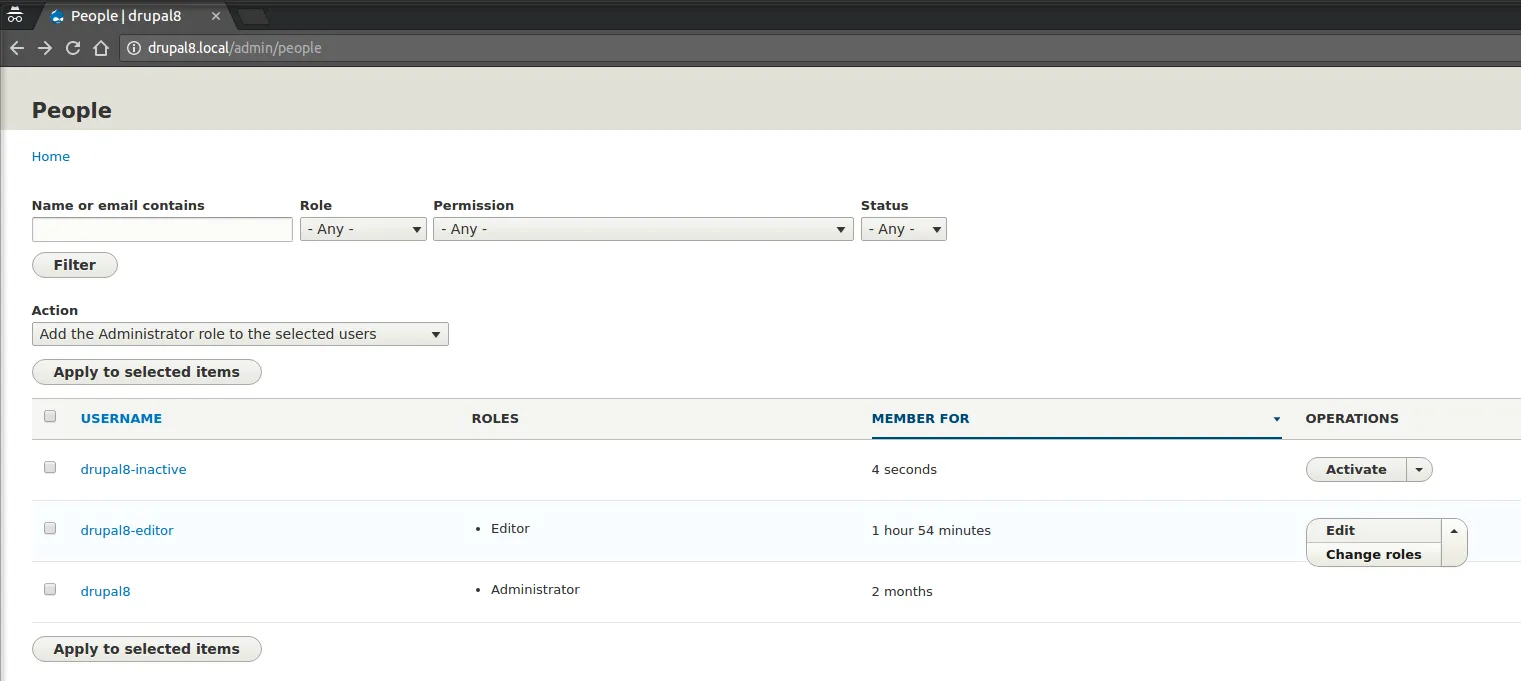
Shopify, on the other hand, offers a more straightforward approach with staff account limits based on the plan: 2 to 15 accounts for standard plans and unlimited accounts with Shopify Plus. It also allows for restricted collaborator accounts, which is helpful for smaller teams. While Shopify’s system is easy to use and sufficient for many businesses, it may not meet the needs of larger organizations requiring extensive user management capabilities.
Shipping and fulfillment
For shipping, Drupal Commerce integrates with major carriers like UPS, USPS, and FedEx via purpose-built modules and third-party solutions like ShipStation. Furthermore, Drupal supports dropshipping via various modules, allowing for customized solutions tailored to specific business needs. While setting up dropshipping on Drupal may involve more technical configuration, its scalability and flexibility offer significant advantages for businesses seeking a highly personalized approach.
Similar to Drupal Commerce, Shopify also supports major shipping carriers integration as named previously. The platform also features automated label printing, real-time tracking, and easy shipping management from the dashboard.
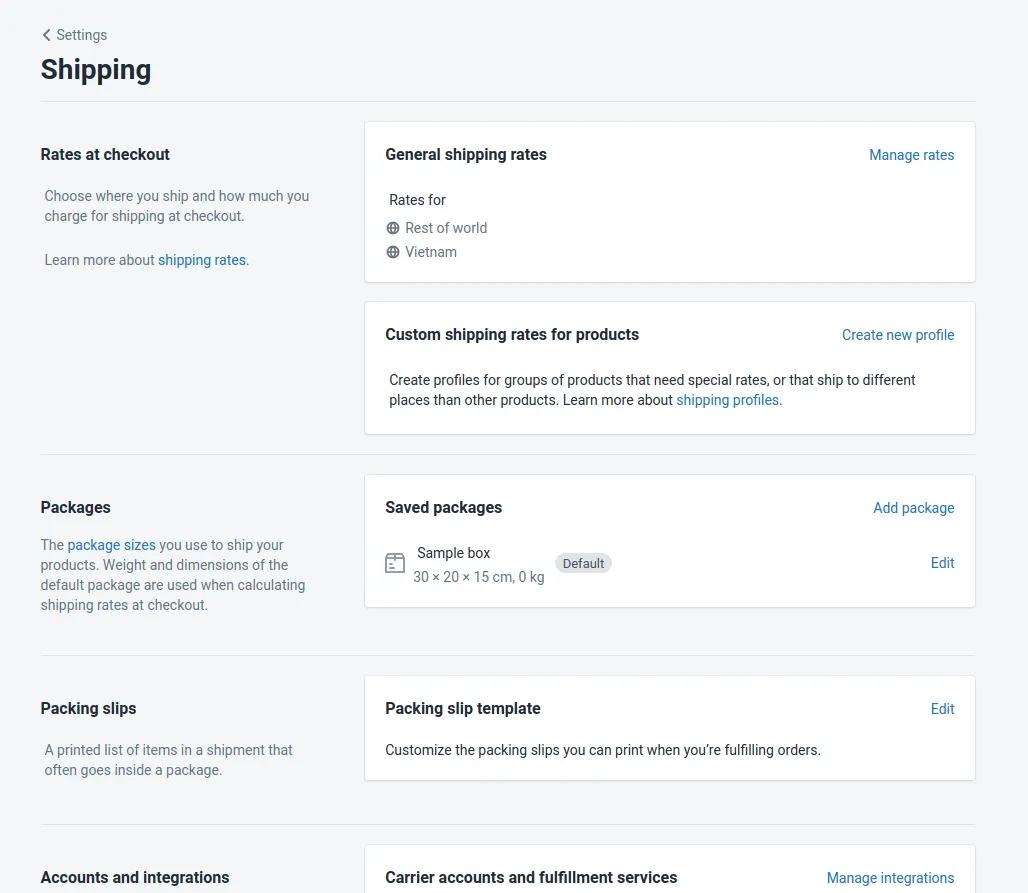
Not to mention, Shopify simplifies dropshipping with direct integration of popular dropshipping apps like Oberlo, AliExpress, and Printify. These integrations streamline the process of adding products to your store, although each marketplace may have varying fees, such as membership or shipping costs.
The Verdict
Our take is that Shopify dominates in the Drupal vs Shopify eCommerce comparison. It offers a robust, user-friendly suite of eCommerce tools that cater to the needs of online businesses, from product management to payment processing and shipping.
5. Payment gateways (Shopify wins)
When evaluating platforms like Drupal vs Shopify, the choice of payment gateways becomes essential. It not only influences transaction fees but also affects how easily you can integrate and manage multiple payment options. A well-suited payment system can enhance global reach, ensure seamless customer experiences, and reduce costs, making it a critical aspect of platform selection.
Drupal payment gateways
In terms of payment integration, Drupal Commerce supports major gateways such as PayPal, Braintree, Authorize.Net, and Stripe. With access to over 100 modules in the Drupal directory, businesses can select from numerous payment methods and local currencies, allowing for tailored solutions that meet international and regional requirements.

Being an open-source content management system, it's evident that payment systems and transaction fees are not a primary focus for Drupal. This is apparent from the optimization level within its toolset. Thus, it may take you more time to set up a fulfilling payment system for the best shopping experience.
Shopify system
Likewise, Shopify also offers a broad range of payment options, supporting over 100 payment processors, including popular names like Stripe, 2Checkout, PayPal, and Authorize.Net. This extensive selection provides flexibility for businesses, though it’s important to note that Shopify charges a transaction fee unless you use Shopify Payments.
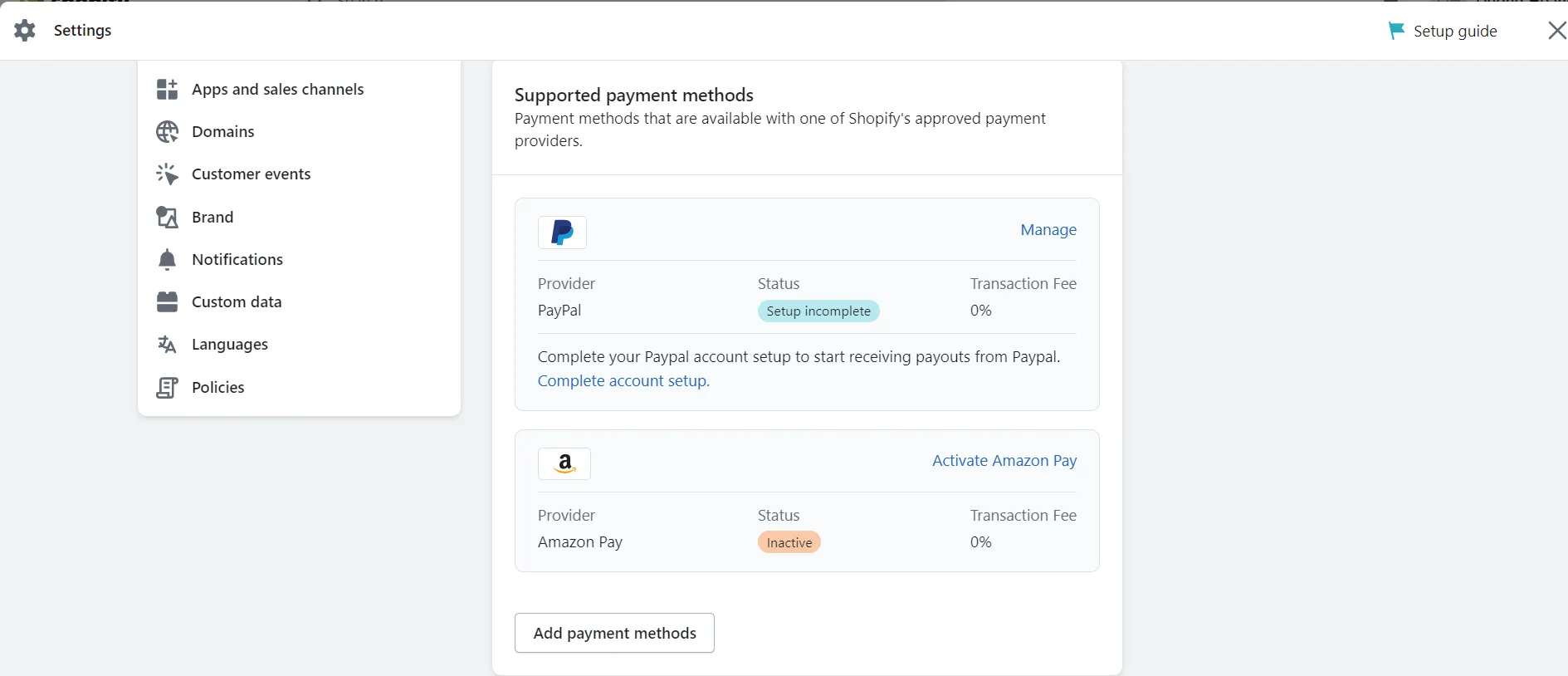
The ability to accept payments in multiple currencies is exclusive to Shopify Payments, which automatically adjusts prices based on current exchange rates. This feature is worth considering if you're expanding into international markets and your region supports Shopify Payments.
The Verdict
Shopify leads the way in the competition between Drupal vs Shopify payment systems. It offers a more user-friendly experience for setting up an online store and doesn’t charge any transaction fees if you use Shopify Payments.
6. Apps & integration (Shopify wins)
A thriving app ecosystem can significantly extend the functionality of your eCommerce platform, allowing you to integrate with essential business tools and services. So, between Drupal vs Shopify, who’s the winner?
Drupal integration
Drupal's active community plays a key role in its vast collection of plugins. When running your online store on Drupal, you will be impressed by its enormous number of modules, which exceeds 52,000. Many of these free modules allow businesses to enhance their websites with valuable features and functionality without incurring additional costs.
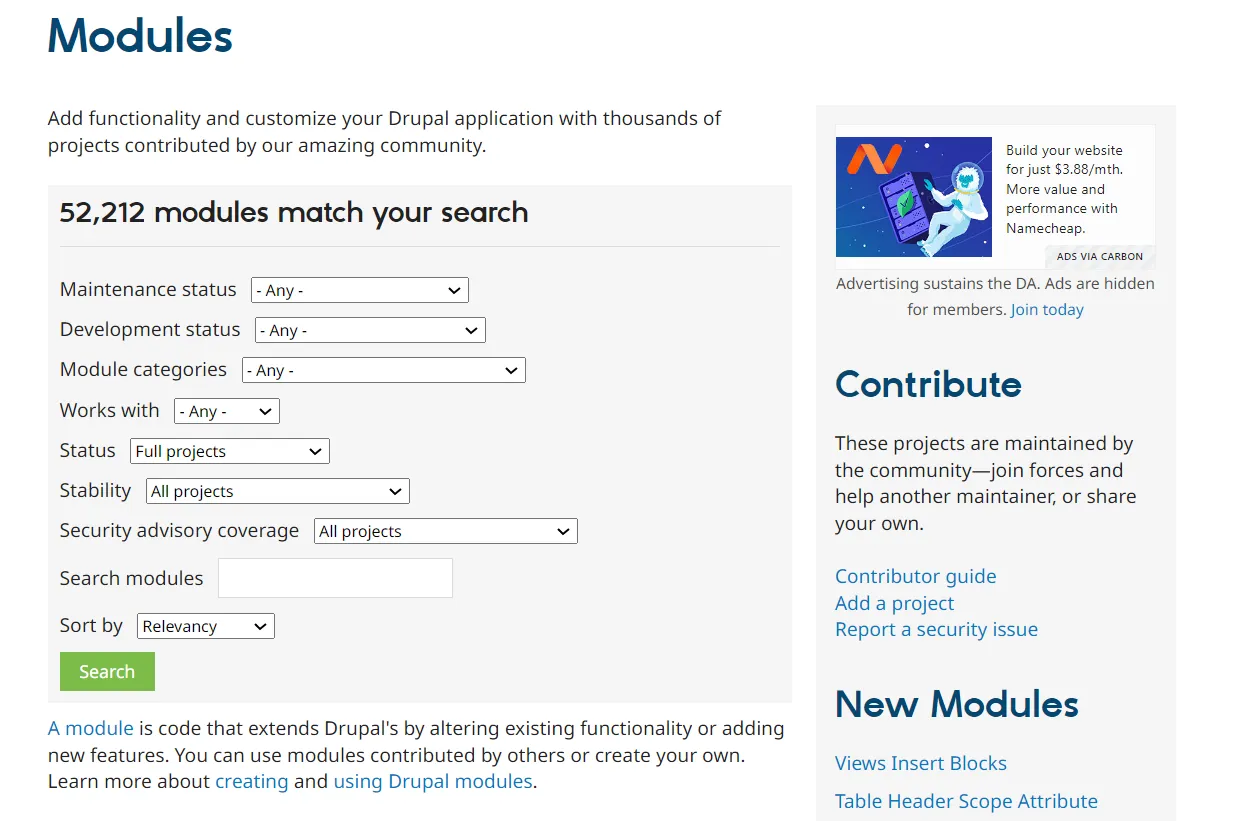
Another key benefit of the platform is the ability to customize modules extensively, even creating new ones from scratch. This flexibility, however, similar to other aspects, requires coding knowledge.
Shopify integration
At the same time, Shopify has up to 13,000 apps for you to choose from. These apps span various categories, from marketing to shipping, with pricing models including free, paid, and freemium options.
While Shopify app customization might be less open-ended than Drupal, it's designed for ease of use and requires minimal technical setup. Installing a Shopify app is simple; it only requires a few clicks from the App Store. This ease of integration makes Shopify appealing to businesses seeking hassle-free functionality expansion.
The Verdict
Both Shopify vs Drupal boast impressive app ecosystems, but Shopify takes a slight lead with its curated selection of eCommerce-focused apps. Shopify’s App Store is a hub for integrations designed to enhance online stores, making finding solutions tailored to your business needs easy.
7. Marketing & SEO
Effective marketing tools enable targeted campaigns and personalized interactions, while robust SEO capabilities improve search engine rankings, making it easier for potential customers to find the business. To determine which platform better supports these critical functions, it's important to compare Drupal vs Shopify's marketing and SEO features.
Drupal marketing & SEO
Recent versions of Drupal offer easier integration with automation platforms. These features allow for personalized email offers, dynamic list management, and integration with AI applications like chatbots. This setup reduces the time required for marketing staff, refines marketing processes, and enhances customer engagement with relevant, personalized content.
To let the audience find you more easily, Drupal’s SEO capabilities are also exceptional. The SEO tools module provides a sophisticated all-in-one suite that includes search engine reporting, analytics, website optimization, and webmaster tools. To further enhance these features, it would be much better to apply some of your coding knowledge.
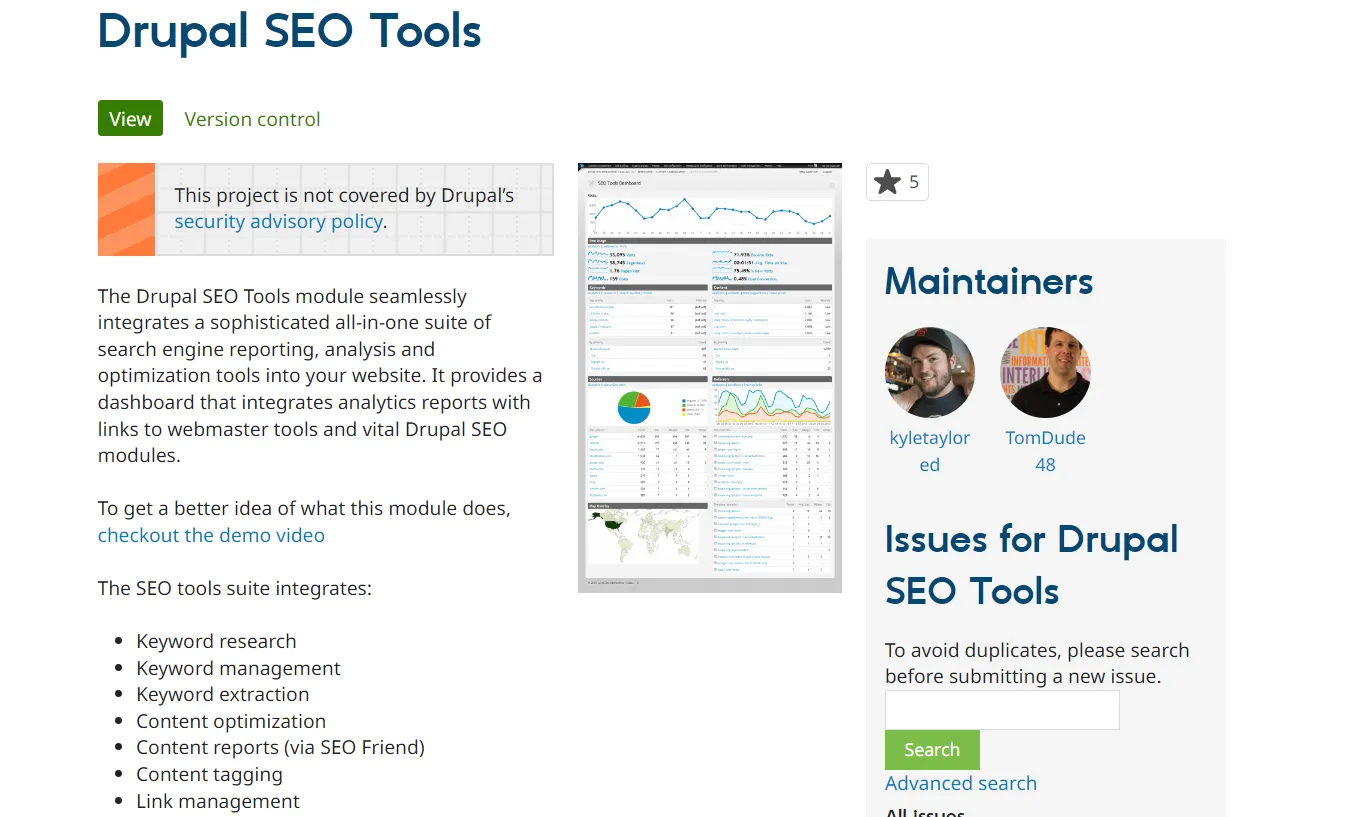
Shopify marketing & SEO
In the meantime, Shopify focuses on streamlined marketing with automated email templates and customizable platforms. These templates allow for automated communication, such as sending welcome emails to new subscribers with personalized branding. However, Shopify's marketing functionalities are relatively limited beyond these email tools.
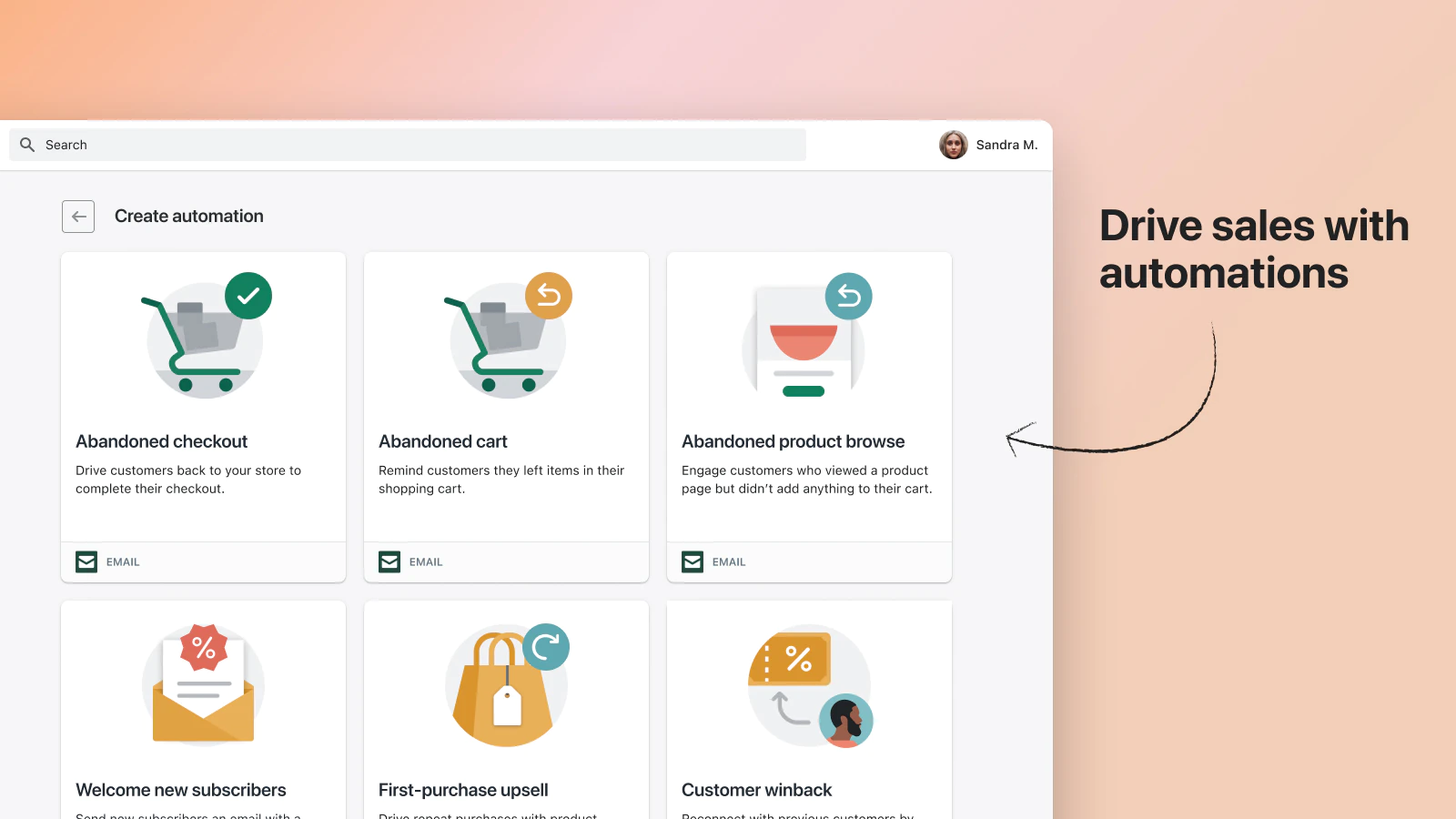
The platform offers essential SEO tools, such as sitemap generation and duplicate content management. However, many store owners find these features limited and turn to third-party SEO apps to further boost their search engine rankings. Some popular names that you can consider are Avada, SearchPie, Sherpas, etc.
The Verdict
Shopify ultimately takes the prize in this Drupal vs Shopify competition for its robust marketing and SEO features, making it more accessible for most businesses. While Drupal provides a more advanced and sophisticated suite of SEO tools, it requires some coding knowledge to utilize its capabilities fully.
8. Security (Drupal wins)
For this section, we will look at the security measures offered by Drupal vs Shopify. Overall, each platform takes different approaches to ensure security compliance.
Drupal security
When putting Drupal vs Shopify together, Drupal is widely regarded for its robust security features. This is because the platform offers granular user permissions, two-factor authentication (2FA), and frequent security updates, making it a favorite for businesses with stringent security needs.
Additionally, Drupal's Security Advisory Team actively monitors the platform, responding rapidly to emerging threats. With its modular structure, users can implement advanced security configurations, which is why many government and enterprise-level websites trust Drupal.
Shopify security
As a hosted platform, Shopify handles security on its users' behalf, offering PCI-DSS compliance out-of-the-box, SSL certificates for encryption, and automatic security updates. Shopify also provides fraud detection tools, secure payment gateways, and regular backups to protect store data.
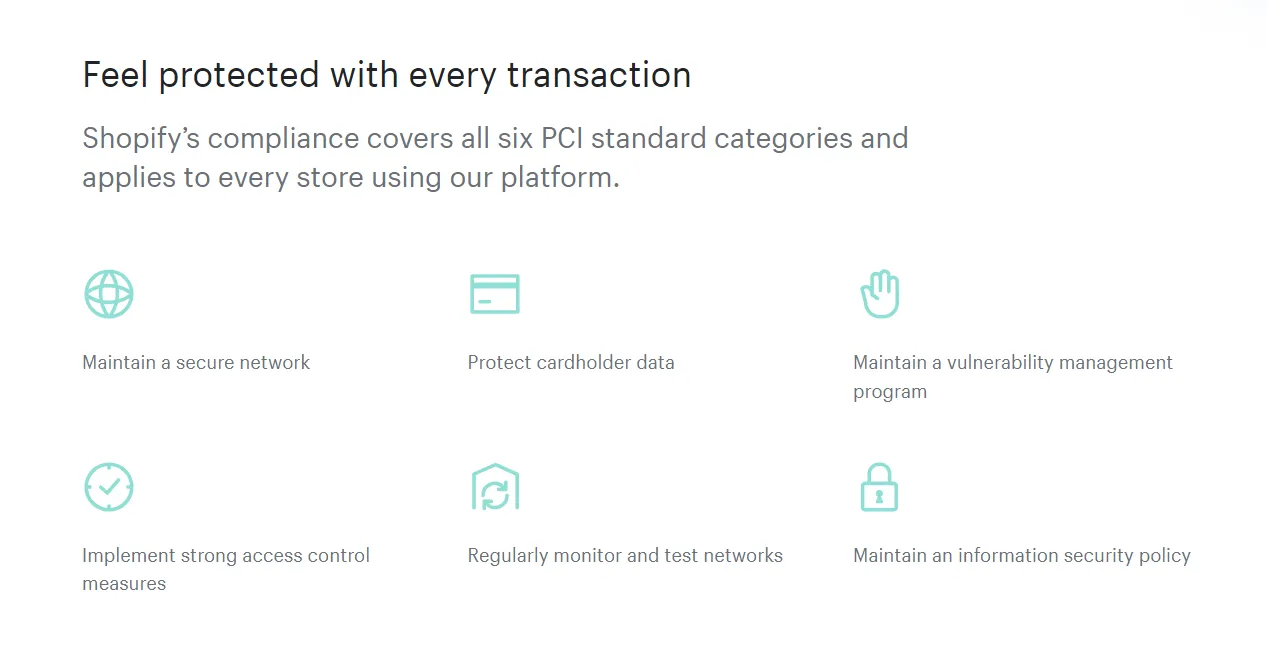
For users looking for a more hands-off approach, Shopify’s security measures are sufficient to cover most standard eCommerce operations. However, the lack of in-depth customization compared to Drupal limits advanced control over specific security configurations.
The Verdict
In comparing Drupal vs Shopify security, Drupal stands out due to its greater customization and control over security measures. Its open-source nature allows businesses to implement advanced, tailored protections, making it ideal for organizations with strict security requirements.
9. Customer support (Shopify wins)
When issues arise in your online retail business, it's reassuring to have reliable support to help resolve them quickly and keep your operations running smoothly. Technical glitches are common, not rare, so it's essential to choose a platform with a strong support system.
Drupal customer support
Drupal operates within an open-source framework, meaning there’s no centralized customer support team. Instead, users tap into a vast and active community of developers with plenty of online documentation, forums, and Q&A platforms.
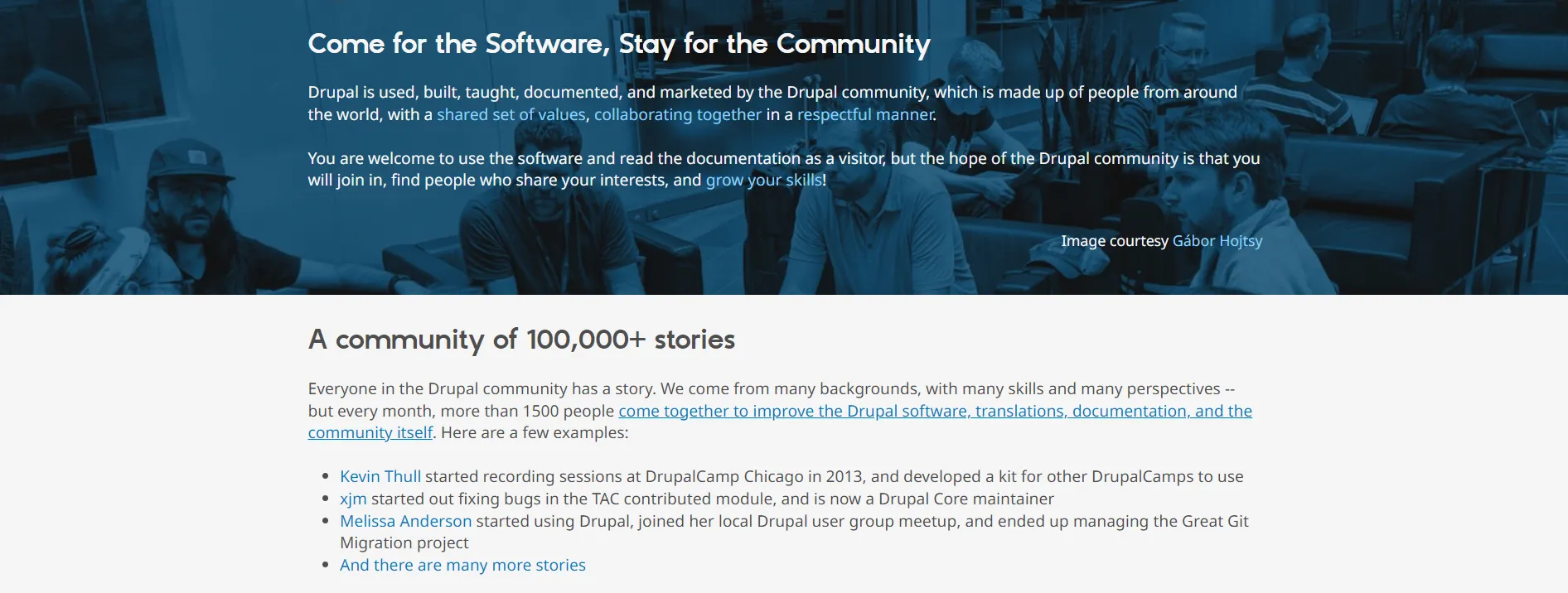
Businesses can also seek paid support from agencies or independent experts specializing in Drupal, adding a layer of professional help for those needing it. This structure offers flexibility but at times, demands patience and technical knowledge to resolve issues.
Shopify customer support
Meanwhile, Shopify provides a far more structured support system. Users benefit from 24/7 customer service across multiple channels, including live chat, phone, and email. Shopify’s support team is well-versed in its platform, making it easy for users to get quick solutions to common issues.
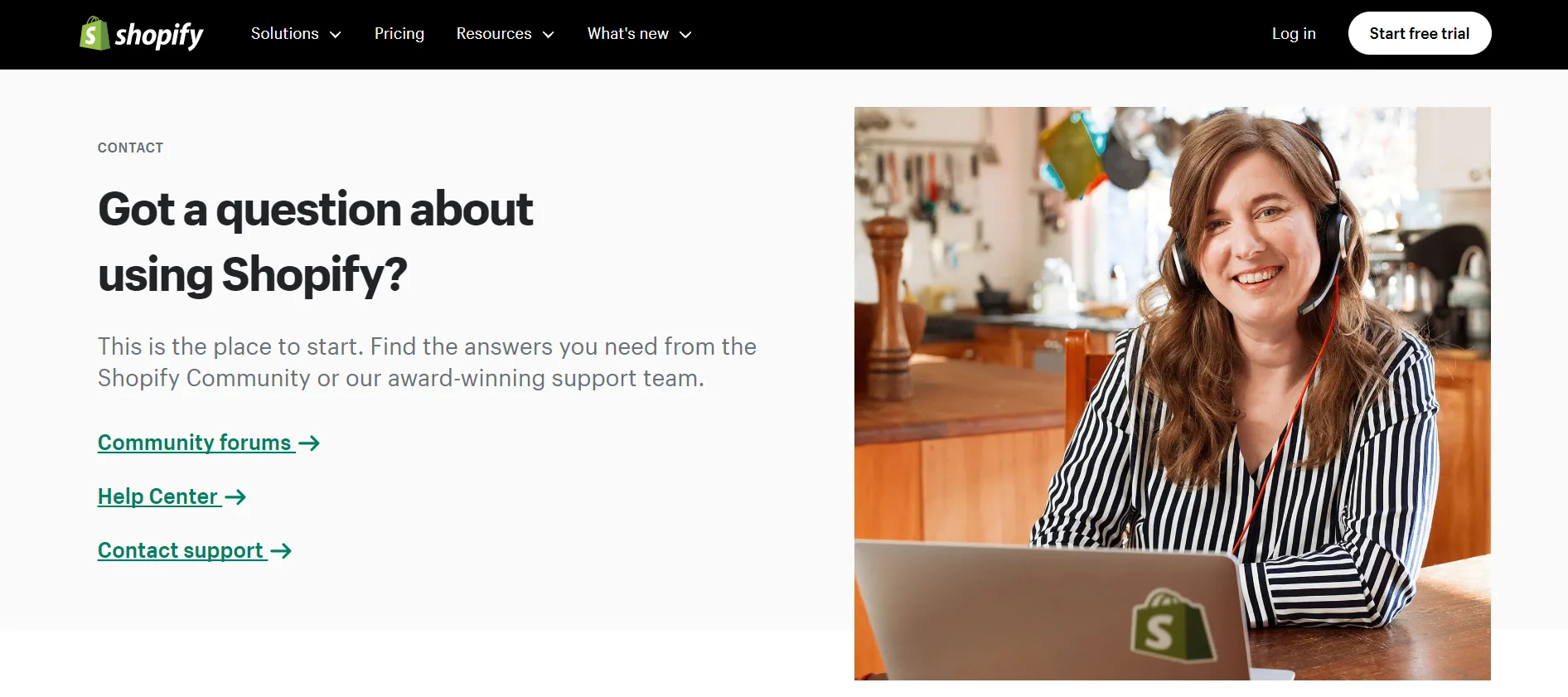
In addition to its dedicated support team, Shopify also offers an extensive knowledge base, video tutorials, and community forums. This level of accessibility and guided assistance makes Shopify an appealing choice for users with limited technical experience.
The Verdict
Needless to say, Shopify has the advantage of a dedicated customer support system that provides round-the-clock assistance and easily accessible help for users. This makes Shopify an appealing option in this Drupal vs Shopify competition for businesses prioritizing ease of use and reliable built-in protection.
Drupal vs Shopify: FAQs
Is Drupal similar to Shopify?
No, Drupal and Shopify are fundamentally different. Shopify is an all-in-one eCommerce platform designed for ease of use, while Drupal is a highly customizable, open-source CMS that requires technical expertise.
Is Drupal good for eCommerce?
Drupal can be excellent for eCommerce, but it's not ideal for everyone. It's best suited for large businesses or those with unique, complex needs that require a high level of customization and scalability. However, this has a trade-off: you'll need skilled developers and potentially higher upfront costs.
Is there a platform better than Shopify?
Shopify might not be ideal if you require a high degree of design flexibility, want open-source access, or need advanced customization beyond Shopify's capabilities. In these cases, platforms like BigCommerce, Magento, or even custom-built solutions might be a better choice.
What is better than Drupal?
If you prioritize ease of use, faster development time, or lower costs, then Shopify, BigCommerce, or other SaaS eCommerce platforms might be more suitable than Drupal. These platforms offer more out-of-the-box functionality and require less technical expertise.
Final Thoughts
Throughout this detailed comparison of all aspects between Drupal vs Shopify, we hope our article today has helped you make the final decision for your business. Shopify is ideal for ease of use and ready-made features, while Drupal offers greater customization for those with the resources to manage it.
If you're thinking about migrating your store to Shopify, our LitExtension migration experts are here to help! With over 12 years of experience and 300,000 successful migrations, we've got you covered. You can even test the process with a free demo, and our support team will be available to guide you every step of the way.
For more insights on other options, please refer to our collection of eCommerce platforms blog or join the Facebook community group!


